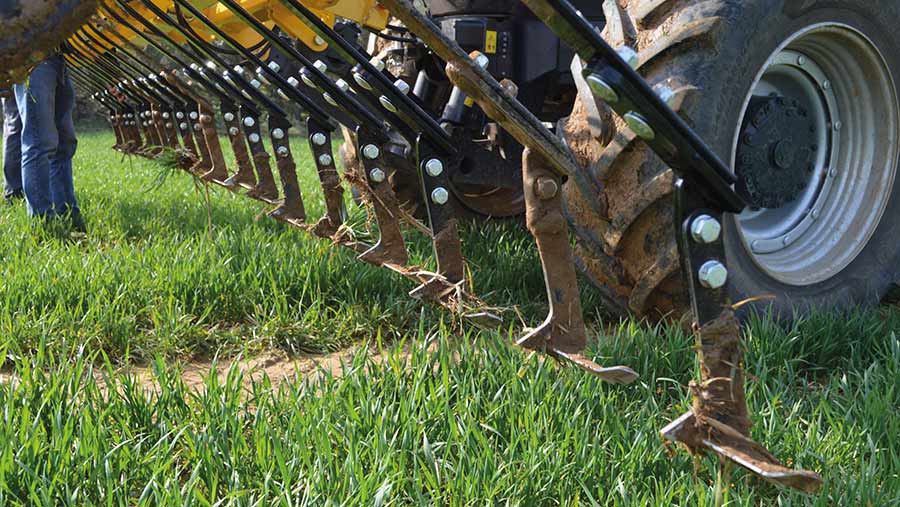Velcourt turns to weed hoeing to cut herbicide costs
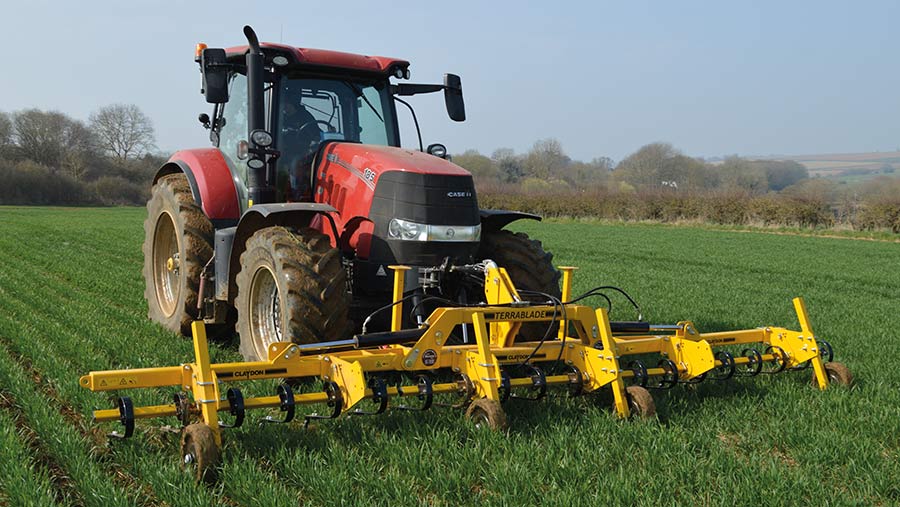 © MAG/David Janes
© MAG/David Janes Mechanical weeding is being trialled, with promising results, in winter wheat and winter beans by one big farming company looking to trim escalating herbicide costs and counter the decline in effectiveness of some weed control treatments.
Oli Pilbeam, manager at Velcourt’s Stamford unit, saw substantial improvements in blackgrass control when a Claydon TerraBlade inter-row hoe was used on loan during the spring of 2021, and was so impressed he bought a 6m-width machine for use this spring.
Mr Pilbeam, who manages 2,600ha of arable land in south Lincolnshire and neighbouring counties, says the ultimate aim of introducing the hoe was to reduce herbicide usage through cultural control. He hopes this will reduce his reliance on delayed drilling, and allow the introduction of second wheats into the rotation on land with high blackgrass pressure.
Autumn blackgrass herbicide programmes in winter wheat crops were costing up to £100/ha in heavily weed-infested fields, and there was a desire for an additional non-chemical tool as part of an integrated strategy for managing this yield-damaging grassweed.
He tells Farmers Weekly: “In high pressure blackgrass fields we are using rotation to control blackgrass and also trying out mechanical weeding as we realise the answer is not always in the herbicide can.”
See also: Pixelfarming Robotics to target UK with autonomous weeder
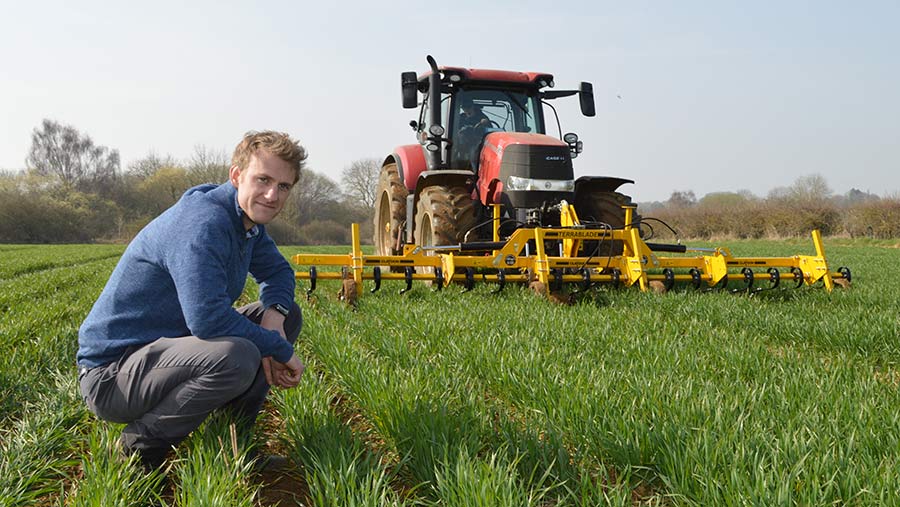
Oli Pilbeam with the Claydon TerraBlade inter-row hoe
Mounting costs
Thoughts first turned to mechanical weeders some three years ago, with spray costs mounting and post-emergence blackgrass herbicides showing an alarming decline in efficacy. The decision was made to buy a new drill to fit both with an inter-row hoeing system, and provide flexibility to cope with the diverse range of soil types on the unit.
The following year, a 6m tined Claydon T6c drill was bought. This has a leading tine followed by a second sprung tine carrying the seed coulter, which sows in a band. This flexible machine can be used for direct drilling and in minimum tillage or plough-based cultivation systems.
The leading tine can loosen compacted ground, let air into the soil, create drainage and some tilth to encourage rooting and above-surface growth, while minimising any soil disturbance to limit weed emergence.
This gave Mr Pilbeam the flexibility of having a tined drill to work alongside an existing 8m disc drill, to deal with a range of soil types from light limestone brash around Stamford to silts and fenland towards Spalding and heavy clays into south Leicestershire and Nottinghamshire.
Machinery loan
The next move was the loan of the 6m TerraBlade, which was used across 150ha of winter wheat and winter beans in spring 2021, and is expected to work an increased area of up 250ha this spring.
The machine is manually steered to control weeds in the band-sown crop during the early crop growth, reducing competition with the crop and weed seed return.
“We are seeing a substantial difference,” Mr Pilbeam says. “It doesn’t remove blackgrass out of the rows, but we are getting significantly better blackgrass control than from using pre- and post-emergence herbicides.
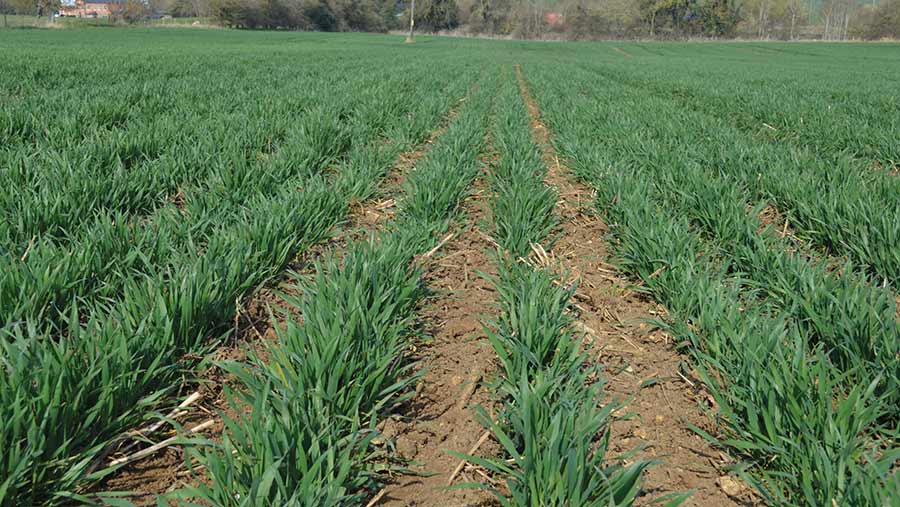
© MAG/David Jones
Work done by Will Smith at crop consultant Niab suggests that hoeing increases blackgrass control by about 20% over a robust herbicide programme, delivering about 70% control. This is in line with Velcourt’s experience in the field.
Spring 2021 saw good results as blackgrass was pulled out between the rows of winter wheat, was not able to re-root in the dry spring conditions, and died. The system looked to be giving a low-cost method of controlling weeds in band-sown crops and also cut the risk of resistant weed types developing.
Good results
The Claydon drill sows wheat in 175mm bands with a 175mm gap between the rows, and so a 150mm-wide hoe share was used. The front-mounted hoe, costing less than £10,000, has given good results with a skilled operator.
Optimal hoeing depth cuts off the blackgrass just below the soil surface. In wet conditions there is a risk of the blackgrass re-rooting, but so far this has not been a significant issue.
There is also a concern that disturbing the soil too much with deeper hoeing could produce another flush of blackgrass, but again this has not been a problem with the weeding system so far. Any plants emerging after hoeing are likely to be smaller and less competitive, returning fewer seeds to the soil.
Mr Pilbeam says the hoeing window closes in winter wheat at growth stage 32, or the T1 fungicide timing, usually towards the end of April, and after that the wheat crop is too tall to operate the weeder successfully. With a narrow working window, the hoe is used strategically, starting at the points with the worst blackgrass pressure, and then radiating out from there.
Practical use
When Farmers Weekly visited at the end of March, the hoe was being used in winter wheat on limestone brash land to the west of Stamford, on the Lincolnshire-Northamptonshire border, and also on a heavier field down towards the River Welland, near the village of Wakerley.
In good dry soil conditions, the mechanical hoe was seen to be pulling out blackgrass plants between the rows and leaving them to dry out and, hopefully, die.
Last season, one hoeing pass was conducted in the spring in the winter wheat, and two spring hoeings were undertaken in crops of winter beans. A range of trials indicate that two or more passes with an inter-row hoe increases the level of control, and where blackgrass pressure is heaviest, a two-pass approach will be taken.
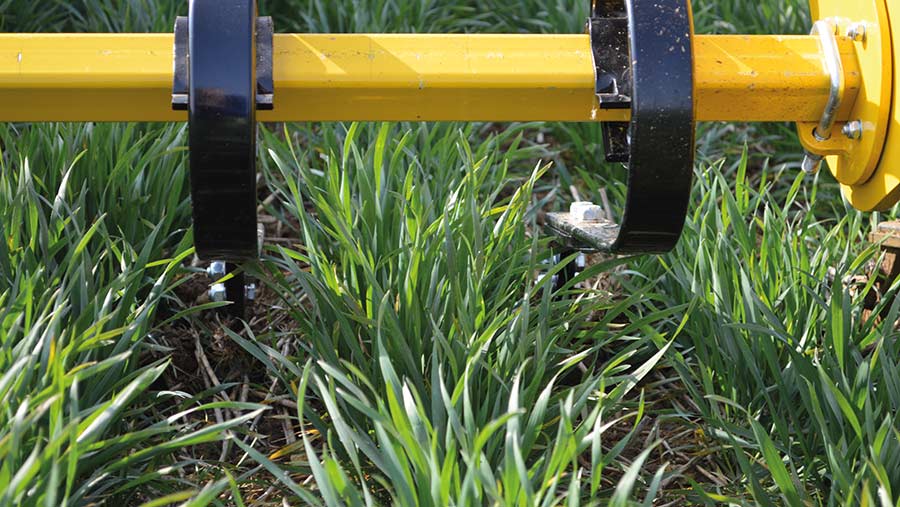
© MAG/David Jones
Mr Pilbeam is also experimenting with using the hoe once in the autumn on earlier-drilled winter wheat crops, and then once in the spring.
Nick Anderson, head of crop production technology at the farming group, says careful consideration needs to be given to how hoeing in the autumn interacts with residual herbicide programmes.
Integrated hoeing
Mr Anderson adds that there is much yet to be learnt about how best to integrate hoeing into grassweed strategies in a range of crops. “Velcourt is doing an amount of field-scale trial work on hoeing to ensure that we and our customers get the best out of this approach,” he says.
Delayed drilling is currently a key cultural element of blackgrass management employed at the Stamford unit. At the moment most of the bad blackgrass land is only drilled from mid-October onwards, while zero or low blackgrass pressure land is drilled from the end of September.
While delayed drilling of winter wheat works well as part of an integrated approach, later drilling is a compromise which increases risk in wet conditions and can lead to yield reductions if establishment is compromised in a wet autumn.
It is hoped that hoeing will allow greater flexibility to establish crops earlier where blackgrass pressure is moderate. “Drilling 10 days to two weeks earlier could significantly increase yield,” says Mr Pilbeam.
With the addition of hoeing to the blackgrass management strategy, he is hoping eventually to pull winter wheat drilling dates back from mid-late October to early October on fields with moderate blackgrass pressure.
Herbicide regime
Currently, post-harvest cultivation practices ahead of winter wheat include a tined cultivator to incorporate chopped straw, and normal blackgrass control consists of Avadex (tri-allate) granules, a pre-emergence treatment of diflufenican/flufenacet and then a further peri-emergence spray of flufenacet, costing in the region of £70/ha.
The addition of other active ingredients such as aclonifen and prosulfocarb to residual programmes can increase herbicide costs to more than £100/ha.
If blackgrass control results are good again this season, Mr Pilbeam will start looking to reduce herbicide costs in the autumn of 2022. “After two seasons of hoeing we may look to try and reduce herbicide costs in the autumn, although this is secondary to optimal blackgrass control,” he says.
Mr Anderson says history shows that relying exclusively upon chemistry for blackgrass control does not work. “We really perceive that, as part of an integrated approach, hoeing will cost-effectively improve overall control,” he says. In turn, he suggests that this will allow greater flexibility around cropping and drilling dates, delivering bottom-line benefits for the group and its customers.

